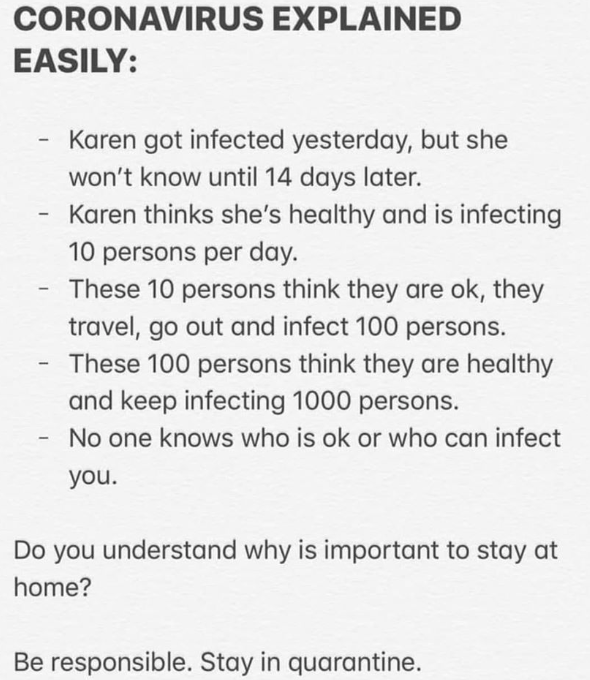Look at this meme that’s going around.

Looks like it makes a reasonable argument, doesn’t it? So, why would I write a post addressing it? Let me give you my short and sweet answer:
I’m writing, because it stops at just three days of going out. I’m writing because the math being used simply doesn’t justify the need for asymptomatic people to stay home. In fact, odds are high that you’re probably immune already (if this math is accurate). Don’t believe me…
Do the Math!
IF Wuhan’s first case is when the Chinese government claims, then the first case was December 10, 2019. (Anyone who doesn’t understand China’s control of media needs to go and truly study what that is and talk with those from other countries who have lived and worked in China. Censorship is an everyday occurrence there.)
Which means the initial exposure was November 26, 2019 (two days before U.S. Thanksgiving, for those not looking at a calendar) at the latest—based on the assumption that the incubation period for this virus is 14 days as reported on March 10, 2020.
This means that we’ve had almost 4 months (short estimate) since the initial outbreak—including at least one month of unrestricted access for travel to and from China.
The first reported case outside of China was January 13, 2020 (just over a month after first reported case) in Thailand—just over two months ago.
This means that in seven weeks (minimum) the virus traveled from central China to Thailand—through China’s most populated provinces.
Two days later, January 15, 2020, the first two US cases were reported.
This virus has now “officially” been in the US for at least:
- Nine and a half weeks (as of March 23, 2020)
- 68 days (as of March 23, 2020)
NOW, let’s use the meme’s formula for the US spread.

Since we “know” that the virus has no apparent signs for 14 days, let’s assume that first case started the spread on January 2, 2020 (14 days earlier). Here are the math facts in this scenario (as of March 23, 2020):
- Total days: 82 days
- If each person infects 10 people a day, today our grand total of infected persons in the US would be:
1,000,000,000,000,000,000,000,000,000,000,000,000,000,000,000,000,000,000,000,000,000,000,000,000,000,000,000
which, in English, is read: one sexvigintilion
(In case you didn’t catch it, that’s 81 zeros after the 1)
Remember:
- This is simply based on that first person not knowing to socially isolate when asymptomatic and doesn’t do the actual exponential equation needed for a truly accurate number.
- This does not account for a scenario of more than one person in the US coming in contact with someone with the virus while travelling abroad during the month and a half no one knew of the virus outside of China.
- This does not account for those coming into contact with the virus before the international travel bans kicked in.
- This does not account for lockdowns being enforced in any country, state, or city.
Now, let’s back up and use the equation with simply take that one person’s two weeks before it was reported—which was definitely before travel bans and isolation were being issued and enforced. How many people were potentially infected during those first 14 days?
ANSWER: 10,000,000,000,000 (that’s 13 zeros and, in English, ten trillion)
In the US, our current (pre-2020 census) population estimate is 327,200,000 (in English: three hundred and twenty-seven million, two hundred thousand). Just in case you can’t visualize the difference in the numbers, let me share it as an image (so the zeros don’t wrap):

Interestingly, using this equation, the potential point at which each person in the U.S. was infected by just one of the two was day 10—January 12, 2020—at the latest. And the world? Well, that means that the whole world potentially was infected by day 12 of the infection—December 8, 2019.
Which really begs the question, why did we wait two more months before we began pushing for the entire nation to go into quarantine? (Assuming the equation’s underlying assumptions are correct.)
Conclusion
What does this mean for us today, March 23, 2020?
- The above equation is completely unreliable for data and needs to be eradicated from our conversations.
OR
- We were all exposed countless times by Valentine’s Day (February 14th) and, therefore, need to reassess just what we are preventing in this situation now by putting asymptomatic people under quarantine.
If numbers don’t lie, the experts have the correct incubation period established, and we’re basing our arguments on the above equation’s logic and assumptions, then these are the only logical conclusions to be drawn.
Which one will you accept?
